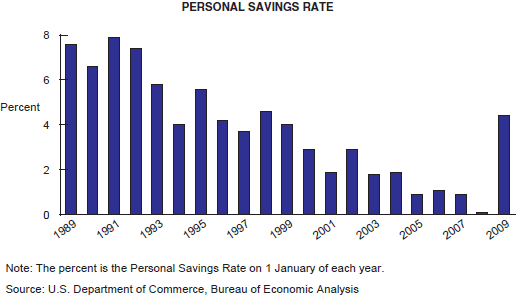Consumers Gain Control Amid Financial Chaos MacroMonitor Marketing Report Vol. IX, No. 3 July 2009
The current economic and financial crisis has drained trillions of dollars of savings and investments from households' balance sheets and has shut off the flow of credit that in the past has helped many households live beyond their means. As a result of sinking stock market and real-estate valuations, growing mistrust of financial professionals, rigid credit markets, and skyrocketing unemployment, living on the financial edge is no longer a sustainable option for many financial consumers. The unfolding financial crisis has forced households to reprioritize both their short- and their long-term financial needs and goals and has put the financial brakes on investing and living precariously on borrowed money. As this recession wears on, a shift in consumer sentiment toward playing it safe may ensue—with households' saving more, spending less, following a budget, and minimizing debt. In fact, harbingers already suggest that households are attempting to gain greater control of their finances: According to the U.S. Department of Commerce, the personal savings rate (the percent of not-consumed personal income) on 1 January of each year, which was hovering near zero in 2008, is at its highest level in more than a decade: 4.4% in January 2009.

As the market downturn that began in September 2008 wears on and as the financial markets recover from the brink of failure and begin to stabilize, financial-services providers face a critical question: How will financial consumers react in the short and in the long term? Understanding consumers' financial state and outlook before the economic downturn and knowing how they will weather the unfolding crisis and what they will do differently going forward are key to financial institutions' survival.
This report sheds some light on where financial consumers were precrisis and what they will do as the economic fallout continues to unfold. The following are highlights from this report:
- Households have been moving closer to the financial edge for some time. While the average debt among all U.S. households increased substantially during the past decade, the average savings balance for all U.S. households increased only modestly.
- Households are increasingly seeing budgeting as a way to regain control of their finances. Also, greater access to Web-based budgeting software may be an indication that households will increase use of budgets in the future.
- Consumers are increasingly taking control of their finances by being more judicious about borrowing. Attitudinal data already point to a change in households' view of credit since 2006, especially with regard to borrowing against their home equity
- Households are tightening control of their finances through their transactions. The use of automatic deposit to savings and investment accounts has been on the rise in the past few years. Meanwhile, households' moving away from the use of credit cards in favor of debit cards to make purchases points to less borrowing and more direct control over spending.
- As households shift in favor of living within their means and playing it safe, they will seek products that offer financial protection such as life insurance. Moreover, financial convenience and simplicity will become even more important to consumers.